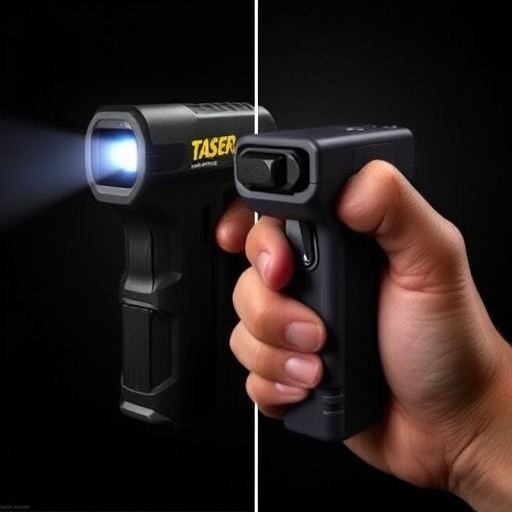Stun guns and tasers are electronic control devices for non-lethal self-defense, differing in mechanism and application. Stun guns deliver high-voltage electrical pulses via metal prongs, causing intense pain and muscle spasms, while tasers fire two thin probes to disrupt muscles and induce temporary paralysis from a distance. Tasers are popular with law enforcement for crowd control, while personal defense tasers have gained civilian use for home protection. The choice between them depends on personal preference and needs, with stun guns offering simplicity and wider coverage versus tasers' longer range and ability to subdue multiple targets in various weather conditions. Understanding these differences is crucial when considering personal safety and legal implications.
Are you considering a stun gun or Taser for home defense? In today’s uncertain world, personal safety is paramount. This guide delves into the differences between stun guns and Tasers, exploring their unique mechanisms and applications. We’ll help you choose the best option for your needs, ensuring you’re prepared to protect yourself and your family. Learn about these powerful tools, their effects, and how they can enhance your security without resorting to lethal force.
What is a Stun Gun and How Does it Work?
A stun gun, also known as an electronic control device (ECD), is a non-lethal weapon designed to temporarily incapacitate a target through electrical impingement. Unlike firearms or knifed-based self-defense tools, stun guns do not kill or permanently harm their victims. They work by delivering a strong electric current through two prongs or probes that make contact with the attacker’s body, disrupting muscle control and causing intense pain, disorientation, and temporary paralysis. This effect allows the user to escape or disable the assailant until law enforcement arrives.
The mechanism of action sets stun guns apart from their cousin, the taser. While both devices use electricity for self-defense, tasers fire two probes connected by a wire, allowing for a longer range and the ability to subdue multiple targets simultaneously. Stun guns, on the other hand, rely on direct contact between the prongs and the attacker’s skin, making them generally more effective in close-quarters situations where distance is limited. This difference in delivery method also influences their power output, with stun guns typically producing a lower voltage than tasers to avoid causing serious injury or permanent damage.
Understanding Tasers: Mechanism and Applications
Tasers, officially known as Electronic Control Devices (ECDs), are non-lethal weapons designed to incapacitate individuals through muscle relaxation and pain compliance. Unlike stun guns that deliver a high voltage electrical discharge, tasers use two small probes connected to wires to administer an electric current, causing the body’s muscles to contract involuntarily. This results in a temporary loss of balance and strength, allowing users to control and subdue an aggressor.
The primary application of tasers is law enforcement, where they are used for crowd control, restraining suspects, and de-escalating potentially violent situations. In recent years, personal defense tasers have gained popularity among civilians, particularly those seeking non-lethal options for home protection. Understanding the difference between stun guns and tasers—while both utilize electricity to disable—is crucial for making an informed decision regarding personal safety and legal considerations.
Choosing Between a Stun Gun and Taser for Personal Safety
When considering options for personal safety at home, understanding the distinct differences between a stun gun and a Taser is essential. Both devices serve as powerful tools to deter and subdue an attacker, but they operate through different mechanisms. A stun gun delivers high-voltage electrical pulses through metal prongs, temporarily incapacitating the target with intense pain and muscle spasms. On the other hand, a Taser fires two thin probes connected to wires, firing an electric charge that disrupts muscles and causes temporary paralysis.
The choice between them depends on personal preference and specific needs. Stun guns are generally easier to use due to their simplicity—a simple point and pull mechanism. They offer a wider range of stop-an-attacker options as the electrical pulse can affect a larger area. Tasers, while slightly more complex in operation, provide a longer range and the ability to disable multiple targets simultaneously with one device. Additionally, Tasers are often considered more reliable in various weather conditions and environments.
